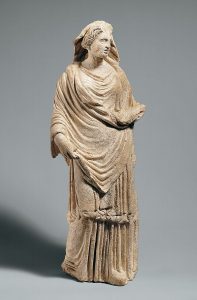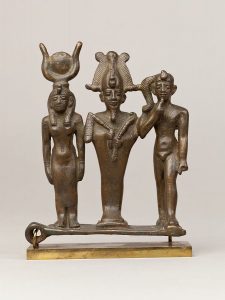Chapter Five – Myth & Ritual
Andy Gurevich
These fertility myths are metaphoric and archetypal. They involve some kind of journey into the underworld where the goddess symbolically dies.

Her death causes the desolation of the earth—crops shrivel, animals die, water disappears—and humans grow weaker. In time, all will die and there will be no one to praise the gods. These goddesses are tied to nature-they are the goddess of the earth, the crops, and all living things. Salvation of the earth occurs when the goddess somehow manages to return to the earth.
But a deal must be made; either the goddess or a representative must return to the underworld for a season.
This explains winter, the season of no growing plants, and it explains the cycle of the seasons—spring is the return of the earth goddess; summer she produces the abundance of the earth; fall celebrates the harvest and the preparations for the goddess’s return to the underworld.
These myths seek to explain the mystery of life and death and the afterlife.
These myths are also known as fertility or vegetation myths. The gods are called “chthonic” pronounced “tonic.” The term means subterranean, or below the earth, so you can see their association with growing plants.
But these myths evolved into a much deeper, much more complex meaning that goes beyond the fertility of the land. These goddesses represent life itself. If the goddess can return from death, is there hope for us?
The cycle of human life mirrors the cycle of the seasons-spring is our birth, summer, our growth to adulthood, fall our productive life when we bring forth new life, and winter, our old age when we still nurture, but will soon die. If the plants can be reborn in the spring, can we? These myths tell us that there is a life after our physical death. It is one of the great mysteries of our existence.
As rituals grew around the worship of these goddesses, they became more formal and became cults, not in our modern sense of cult. The most wide-spread cult was that of Isis. Originating in Egypt, it spread to Greece, Italy, and beyond. It persisted until the 4th century CE. The early Roman Catholic Church had an extremely difficult time suppressing it.

The next important cult was that of Demeter, in Greece. Historians from the earliest times knew little about this cult. There was an elaborate initiation ritual and certain requirements to join. Initiates had to be Greek-speakers, slaves could join at the consent of their masters. Every spring, initiates walked from Athens to Eleusis, the location of the shrine of Demeter.
The march was to honor Demeter’s search for Persephone after she was abducted to the underworld by Hades. Initiates fasted, drinking only kykeon, a mixture of barley, water and honey. Once the initiates reached Eleusis, they sacrificed a pig, cleansed themselves in the waters, and prepared to be admitted to the cult. Once in the temple, the ceremony included specific rites performed.
The important thing about these rites was that they were secret. Once initiated into the cult, members were forbidden, under penalty of death, to speak about the rites.
Over time, scholars were able to piece together what we know about the cults today. As we can see from Homer’s hymns to Demeter, part of the mystery involved a type of symbolic rebirth, giving a hope of life after death. Persephone, representing spring, is abducted by Hades, god of the Underworld. He intends to marry her (how’s that for a metaphor!) Demeter searches in vain for her daughter. In her grief, the land is rendered barren, and nothing can grow.
After Demeter’s futile search, she finally bargains with Zeus for Persephone’s return. But Persephone has already eaten a single seed of the pomegranate; she has eaten the food of the dead. So, she is allowed to return for the spring, summer and fall, the fertile seasons, but must return to Hades for the winter.
Check the following link to read about the rites of Demeter at Eleusis: Eleusinian Mysteries
Osiris, Isis, and Horus

For ritual and the message of life after death, the myth of Osiris, Isis and Horus clearly
shows the impact myths can have on a society. From the myth arose the complex burial practices of Egypt. The Egyptian Book of the Dead outlines the processes, the prayers, and the confessions one must perform in order to make the journey to the afterlife.
Isis became a cult figure for several reasons: she did bring Osiris back to life for the purpose of becoming impregnated with Horus. Here, the myth closely ties life and death—from death comes life.
As your read the myth in our text, you will see that there is a close tie between death and sex; Isis fans life into Osiris and he lives long enough to impregnate Isis with Horus. The cycle is complete, and the generations will go on. So, the message is, life comes from death. (For many centuries, people thought that every orgasm was like a little death: the French call it “la petite mort” literally the little death.)
Most religions address the issue of an afterlife in a very similar way to the Greek and Egyptian. Our funeral rites are a direct evolution of the Egyptian Book of the Dead. Why would we want to preserve a body for as long as possible? But more than that, our religions have us look to a movement to a life different than that on earth, but a life nonetheless, often with rewards and comfort we do not get in our earthly lives.
It’s a great metaphor for the rebirth of the soul into the afterlife. Isis is also the goddess of crops and other growing things. She is fertility. Isis is mother, the giver and sustainer of life. Osiris takes on the role of final judge in the soul’s journey to immortality. It is he who oversees the weighing of the heart, hears the confession, and welcomes the soul into the afterlife.

Sedna
How can a culture so far removed from the fertility of the Nile and Greece have such a similar myth? The Inuit do not grow any crops, yet Sedna represents fertility. Life comes from her very body.
Unlike the other myths, Sedna does not return in the spring, but stays beneath the seas. In place of winter, the fish and sea mammals are held back from the hunters when Sedna is angered because her hair is tangled. But notice the shaman must go down into the sea (the parallel of the underworld) to appease her and comb her hair so she will return the bounty of the seas to the people.
The same metaphors are here as in the other myths. Perhaps more so than the creation myths, these myths show the archetypal pattern of the descent into the underworld, and the return of the god or goddess with hope for life after death.
Other myths with this same basic archetype are Dionysius, Orpheus, Attis, Adonis, and Innana from Sumer/Babylon. You may want to read them, and they are easily found on the internet.
Readings:
- History of Inuit Myth
- Sedna, Inuit

